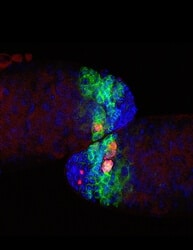The institute's scientists discovered the mechanism responsible for the death of some of the germ cells, from which sperm cells are formed

To save life, you sometimes need to know as much as possible about death, especially cell death. For example, cancer chemotherapy activates a cellular death program called apoptosis. But if the molecular mechanism of apoptosis is defective, or if the cancer cells learn to avoid activating apoptosis, which often happens, chemotherapy stops being useful. Therefore, the discovery by Weizmann Institute of Science scientists, that there is a natural alternative death pathway in germ cells, may make an important contribution to the development of life-saving treatments in the future.
Dr. Eli Arma and senior intern Dr. Karen Yacovi-Sharon, together with research student Yuval Namder, all from the Department of Molecular Genetics, discovered the mechanism responsible for the death of some of the germ cells - from which sperm cells are formed - in the testes of an adult fruit fly. The sperm cells are created in an apparently wasteful way, and this is probably for the purpose of quality control: many germ cells are constantly created, but many of them die. The scientists followed the death of these cells in the animal, the fruit fly, and thus were able to find out in detail the mechanism of death.
In the first step, the scientists realized that it was not apoptosis, which is the most common type of cell death. They showed that the caspases - the destructive enzymes that carry out apoptosis - are not involved in the death of the germ cells.
Later, the scientists defined the structural characteristics of germ cell death: similar to apoptosis, the entire cell and its nucleus shrink, and the DNA becomes fragmented. But other features of apoptosis do not appear. In addition, unlike in apoptosis, entire areas of the cell degenerate, and the mitochondria, the organelles responsible for the production of energy in the cell, appear distorted.
The scientists discovered that the mitochondria play a central role in the death of the germ cells: in these organelles, a gene called htrA2 (also called omi) is activated, which produces a destructive protease-type enzyme. The fact that this gene exists in various creatures, from bacteria to mammals, indicates that the findings of the research done at the Weizmann Institute on the fruit fly may also be relevant to humans. Another component in the death of germ cells is an organelle called a lysosome, a kind of acidic "stomach" of the cell, which contains enzymes that break down cellular waste. In certain types of cell death, the lysosomes leak into the cell, and thus can contribute to the destruction of the cell.
Why does the cell need an alternative death mechanism? One possible explanation is, the germ cell names are evolutionarily earlier. This opinion is supported, among other things, by the existence of a death pathway similar to the death of germ cells in flowers and yeasts as well. Also, in multicellular organisms, the caspases perform other functions that are not related to cell death, which supports the belief that the apoptosis pathway is probably an evolutionarily younger mechanism.
An in-depth knowledge of the germ cell death mechanism may be important in several respects. For example, it can help to understand the formation process of testicular cancer, in which the germ cells in the testicles multiply without restraint. On a more general level, such studies may help to develop anti-cancer drugs that will kill cells through a completely different mechanism - thus helping to overcome the drug resistance that sometimes develops following more routine chemotherapy.

